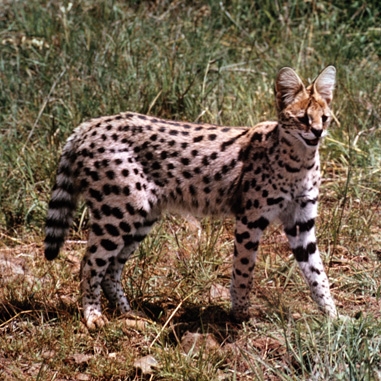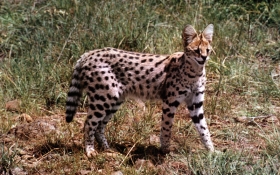
Serval
Leptailurus serval
Animal Behavior: African servals hunt during early morning and late afternoon and rest at mid-day and occasionally at night. Hunting movements range about 2.4 km per day and about half that distance per night. During the dry season, hunting movements decrease. Best concealed in the tall grass, African servals slink in open areas until cover is found again. Territory is marked in several ways, all of which increase when another serval is present or detected. Methods of marking include spraying urine, rubbing the side of the face (which contain scent glands) on the ground or brush, defecation, and marking/scratching the ground. Servals are not social, but in some cases, when a male and female encounter each other, they may travel, hunt, and rest together for short periods. Females tend to be more active than males.
Eating Habits: African servals are crepuscular, hunting several times a night and early morning. If human habitation is close, servals may become nocturnal when hunting. Their diet consists of 93.5% small mammals (rats, mice, and shrews) and 5% birds with the remainder including occasional insects, frogs, lizards, and very rarely carrion. They have a hunting success rate of 48%, higher than other members of the family Felidae. This success rate was observed in successfully reintroduced and wild servals. Hunts early in the morning have a lower rate of success yet have higher yield of prey (about 10) than in the evening (about 6).
Range: African servals are most commonly found in reed beds and grasslands, which primarily consist of Themeda triandra. They also spend time in forest brush, bamboo thickets, marshes, and streams within their home range. The average annual temperature within the geographic range of African servals is 13.7 °C and the average rainfall 826 mm/year. Members of this species in the Ngorongoro Crater in Tanzania are found at elevations between 1400 and 2200 m where winters are mild and there is occasional snowfall.
Conservation Efforts: Increasing human populations and agricultural development have reduced habitat for both African servals and their prey. This may lead to hunting of livestock, as it is an easy and highly nutritious meal. Though the impact of servals on agriculture is minimal, they are regularly shot on site by farmers. Reintroduction of captive-raised servals has been attempted, but there has been difficulty introducing them too close to human habitations. Studies have used radio transmitters to show that most effective releases are at least 10 km from humans at a site with sufficient prey. Although African servals are listed as a species of least concern by the IUCN, the subspecies Leptailurus serval constantina is listed as endangered by the US Fish and Wildlife Service.
